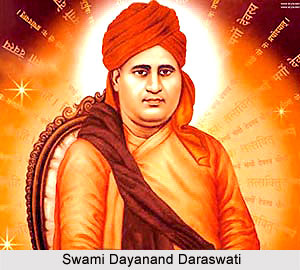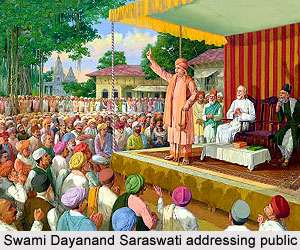 The Arya Samaj was an organisation founded by Swami Dayanand Saraswati and was aimed at making significant social and religious reforms. The Samaj was founded in Punjab and operated mostly in that region. The ideology of the Samaj was based on the thoughts of Dayanand Saraswati and he wanted to purify Hinduism and save it from its contemporary degenerate state. The reforms of Arya Samaj were mostly in the religious field and the Samaj brought about significant changes in the social field as well.
The Arya Samaj was an organisation founded by Swami Dayanand Saraswati and was aimed at making significant social and religious reforms. The Samaj was founded in Punjab and operated mostly in that region. The ideology of the Samaj was based on the thoughts of Dayanand Saraswati and he wanted to purify Hinduism and save it from its contemporary degenerate state. The reforms of Arya Samaj were mostly in the religious field and the Samaj brought about significant changes in the social field as well.
The Arya Samaj spread the idea of a purified Hinduism that would reject the popular Puranas, polytheism, idolatry, the role of Brahman priests, pilgrimages, nearly all rituals and also the ban on widow marriage. The Samaj condemned the orthodox Hinduism, Christianity, Islam, Buddhism, Jainism and Sikhism and believed that there was only one true faith, Vedic Hinduism. The Arya Samaj raised its voice against idolatry, child marriage, elaborate rituals, the Brahman priests, etc. and also insisted on the infallibility of the Vedas, at the same time. However, the Arya Samaj did not have any central organisation and various branches of the Samaj operated independently.
The disciples of Dayanand Saraswati, who carried forward his teachings after his death, unanimously decided to found a school that would impart the Aryan form of Hinduism. The Arya Samaj was inclined to spread the religious education among the common men and thus brought about a significant social reform. With efforts from the Lahore Samaj, the newly founded Dayananda Anglo-Vedic Trust and Management Society became successful to establish the school on 1st June, 1886. The school was later upgraded to Dayananda Anglo-Vedic College on 18th May, 1889, by the Punjab University. Both the high school and college got significant success, as the students trained in this institution demonstrated the quality of their education in the annual examinations.
 After the success of the high school and the college maintained by the Dayananda Anglo-Vedic Trust and Management Society, another formal representative body was convened. The new representative body was convened in October, 1886 and was named as the Arya Pratinidhi Sabha, Punjab. Representatives from the branches of Arya Samaj through Punjab attended the Pratinidhi Sabha and it dealt with variety of questions and provided a degree of centralisation that was missing since Dayanand`s death. The local branches of Arya Samajes also started to build elementary and secondary schools through Punjab, following the model of the Lahore school. The Arya Samaj also started a campaign to collect funds for orphan relief.
After the success of the high school and the college maintained by the Dayananda Anglo-Vedic Trust and Management Society, another formal representative body was convened. The new representative body was convened in October, 1886 and was named as the Arya Pratinidhi Sabha, Punjab. Representatives from the branches of Arya Samaj through Punjab attended the Pratinidhi Sabha and it dealt with variety of questions and provided a degree of centralisation that was missing since Dayanand`s death. The local branches of Arya Samajes also started to build elementary and secondary schools through Punjab, following the model of the Lahore school. The Arya Samaj also started a campaign to collect funds for orphan relief.
However, the split in the Arya Samaj in 1893 led to the foundation of Arya Pradeshik Pratinidhi Sabha and the objective of the two divisions was also different. While the Arya Pratinidhi Sabha continued with their main purpose of spreading education, the other group replaced the purpose with an emphasis on Ved Prachar (proselytism and preaching). It created a plan for professional missionaries and in November, 1895, it hired six full-time missionaries to preach and work with the local Arya Samaj branches. There were also many volunteers to aid the missionaries. The Samaj published newspapers in both English and the vernacular languages to spread the Vedic knowledge as well.
The Shuddhi ritual was one of the most important reforms of Arya Samaj during the nineteenth century. Hinduism traditionally lacked a conversion ritual and the Shuddhi ritual was developed by the Arya Samaj to serve this purpose. During the last half of nineteenth century and first half of twentieth century, many lower caste Hindus were converted to Islam and Christianity and the Arya Samaj was deeply concerned with this large scale conversion. The Samaj developed the Shuddhi ritual to readmit the converted Hindus to Hinduism. Initially, the Samaj employed the Shuddhi ritual to purify and readmit the Hindus who had converted to Islam or Christianity; however, soon it was performed for anyone whose ancestors had once been Hindus.
In addition to Ved Prachar and Shuddhi, the Arya Samaj also worked for the cause of spreading education, especially women education. The leaders of Arya Samaj in Jullundur like Lala Munshi Ram (later known as Swami Shraddhanand), Lala Dev Raj, etc. established a girls` school by the early 1890s. The school was christened as the Arya Kanya Pathshala and was established to provide the women an education safe from missionary influence. They also founded the Kanya Ashram or women`s hostel. Arya Samaj got significant success with the Kanya Pathshala and encouraged by this success, it decided to expand towards higher education. The Samaj established the Kanya Mahavidyalaya on 14th June 1896 to provide the women with higher education and though initially it was an extension of the older school, it grew steadily. Soon, the Mahavidyalaya became a fully developed high school and eventually a women`s college. The students of the college included a mixture of unmarried, married and widowed women.
One of the major reforms of Arya Samaj was advocating for widow remarriage. The Samaj always raised its voice for widow remarriage and it launched societies to support such marriages and to put these ideals into practice. Mainly due to the efforts made by the Arya Samaj, widow remarriage soon became increasingly acceptable among Punjabi Hindus. However, only the remarriage of virgin widows was being accepted in the late nineteenth century.
In 1898, the Arya Pratinidhi Sabha of Punjab decided to establish an institution, where the students would follow a life of celibacy, discipline and Vedic learning. The institution was established in Hardwar on 22nd March, 1902 and was named as the Gurukula Kangri. The students were taught residentially in the institution, under strict faculty discipline. They learned selected western subjects through the lens of Aryan ideals, Hindu scriptures and the vernacular languages.
The reforms of Arya Samaj were mainly aimed at improving the educational scenario of Punjab and also at disseminating the Vedic knowledge among the common people. Education had always been one of the principal objectives of Arya Samaj. Apart from spreading education, the Samaj also raised its voice against the evil rituals practiced in the Hindu society and strongly supported widow remarriage. The Arya Samaj also introduced a unique concept of Shuddhi ritual that was intended at readmitting the converted Hindus to Hinduism. As a whole, it can be said that the reforms of Arya Samaj were of great significance and made huge impacts on the contemporary Hindu society in Punjab. The Arya Samaj became a major acculturative movement with its purified Vedic Hinduism.



















